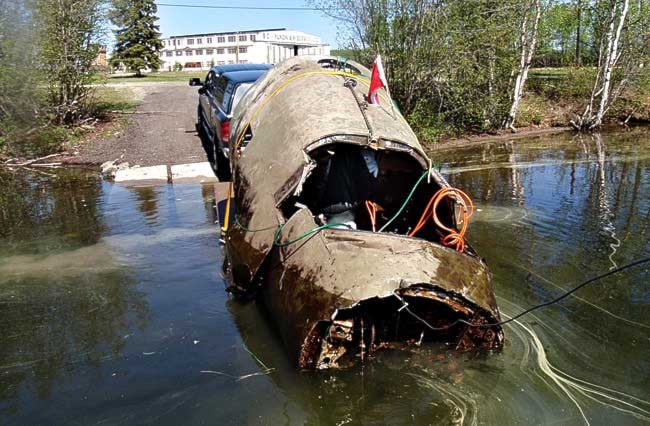Once the settlement is final, all charges and claims will be dropped regarding a Second World War bomber pulled from Watson Lake in 2009.
Albertan John Jasman and the Yukon government struck an out of court settlement late last week.
Jasman, along with his brother Brian, wife Cindy and son Matt pulled the nose section of a 1942 B-26 Marauder out of the southern Yukon lake in June 2009.
Within days, the RCMP confiscated the wreckage and charged the Jasmans with not having the proper heritage permits.
On May 27, Jasman filed a claim against the Yukon, Canada and United States governments for the bomber wreckage to be returned to him, or for adequate salvage compensation.
No settlement amount has been released, but the Yukon government is expected to keep the artifact.
There are no plans to restore the bomber nose for display in a Yukon museum just yet, but there is a “hope” that avenue can be explored at a later date, said officials with the Department of Tourism and Culture.
The Jasmans’ hunt for the bomber began with Brian and John’s father, who worked as a bush pilot in the Watson Lake area for many years.
He told his sons about the fleet of wrecked planes rumored to be in the depths of Yukon’s waters.
Brian started looking for the Marauder decades ago, and tracked down the original crash report, which confirmed on January 16, 1942, the bomber crashed due to “inexperience with snow-blanketed terrain.”
The plane went down while trying to land at the Watson Lake airport during the United States’ efforts to defend Alaska from possible attacks after Pearl Harbor.
No one died in the crash, one crewmember broke an arm, the fuselage was kept for fire-training and the nose was stripped of parts and dragged out onto the frozen lake for target practice.
When the ice melted, the remains of the nose sank. The family eventually found it with high-tech equipment in 2008.
At that time, they alerted the Yukon government with their plans to pull it out.
They also contacted Ottawa, the Canadian Coast Guard and a salvage lawyer. Nobody objected to the Jasmans’ plans and, in fact, the coast guard and salvage lawyer encouraged them.
When the bomber nose was brought up to shore, the Jasmans received local support and encouragement and guidance from the Marauder Society in the United States.
Then Yukon’s heritage resources branch of Department of Tourism and Culture stepped in. They prevented the Jasmans from keeping the artifact, or for selling it for profit.
The Jasmans tried to work with the Yukon on the salvage operation. The territory knows of other downed planed in the region. At least five wrecks are believed to be scattered around the territory.
With notes from the Yukon News.
Contact Roxanne Stasyszyn at roxannes@yukon-news.com
